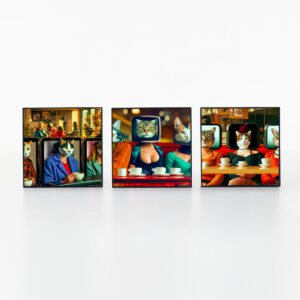
Fake Cheese: Examining Safety, Creativity, and Innovation in the Food Industry
Cheese has been a beloved food item for centuries, enjoyed by people of all ages and backgrounds. But with the advent of modern technology and the increasing demand for convenience, a new type of cheese has emerged: fake cheese. This product is often made from non-dairy ingredients and is designed to mimic the taste and texture of real cheese. However, there are concerns about the safety of fake cheese and its impact on health. In this blog post, we will examine both sides of the debate and try to answer the question: is the invention of fake cheese dangerous or extremely creative? First a bit of history.
History About Fake Cheese, Creativity, And Innovation
The history of fake cheese dates back to ancient times when people began experimenting with different ways to preserve milk. One of the earliest forms of fake cheese was made by the Greeks, who would use rennet to curdle milk and create a cheese-like substance.
Over time, as technology and innovation progressed, manufacturers began experimenting with different non-dairy ingredients to create fake cheese. In the early 1900s, a chemist named Fritz Stettler invented a type of processed cheese made from a blend of milk, whey, and other ingredients. This was the first commercially successful fake cheese, and it paved the way for other manufacturers to experiment with different ingredients and processes to create their own versions of fake cheese.
In the decades that followed, the popularity of fake cheese grew as consumers sought out more convenient and affordable options. Today, there are a wide variety of fake cheese products on the market, made from everything from soy to nuts to coconut oil.
The invention of fake cheese has required a great deal of creativity and innovation in the food industry. Manufacturers have had to develop new methods and technologies to create a product that mimics the taste and texture of real cheese, while also addressing concerns about health and safety. This has led to the development of new ingredients and processes, such as using vegetable proteins or fermentation techniques, and has resulted in a range of innovative and creative solutions to meet consumer demand for convenient and affordable cheese alternatives.
Is The Invention Of Fake Cheese Dangerous Or Extremely Creative?
On one hand, the invention of fake cheese can be seen as extremely creative. It solves a significant problem that many people face: the short shelf life of dairy products. Real cheese can spoil quickly, making it difficult to keep it on the shelves for extended periods. In contrast, fake cheese can last for months without spoiling, making it a much more practical option for many consumers. Additionally, fake cheese is often more affordable than real cheese, making it accessible to a wider range of people.
However, on the other hand, there are serious concerns about the safety of fake cheese. Many fake cheese products are highly processed and contain a range of additives and preservatives. These additives and preservatives can be harmful to health, leading to a range of health issues such as obesity, heart disease, and diabetes. Additionally, some fake cheese products may contain high levels of sodium, which can lead to high blood pressure and other health problems.
Furthermore, some fake cheese products may be marketed as “healthy” or “vegan” alternatives to real cheese, but they may not actually be any healthier. For example, some vegan cheese products contain high levels of saturated fat, which can be just as harmful as animal-based saturated fat.
Invention Demonstrates Creativity
The invention of fake cheese also demonstrates creativity in the food industry. Creating a product that mimics the taste and texture of real cheese requires a lot of experimentation and innovation. Manufacturers have had to develop new methods and technologies to create a product that not only tastes good but also has a similar texture to real cheese. This has led to the development of new ingredients and processes, such as using vegetable proteins or fermentation techniques. Furthermore, the demand for vegan and plant-based options has increased in recent years, and manufacturers have responded with creative solutions to meet this demand. Overall, the invention of fake cheese shows how creativity and innovation can be used to solve problems and meet consumer needs in the food industry.
In conclusion, while the invention of fake cheese may have solved some problems related to the shelf life of dairy products, it has also raised significant concerns about the safety of these products. Consumers should be aware of the potential health risks associated with fake cheese and should carefully read labels and ingredient lists before making a purchase. Additionally, they should consider incorporating more whole, unprocessed foods into their diets, including real cheese in moderation, to promote optimal health.
Ponder Another Creativity Question: Is creativity the gateway too wealth?








